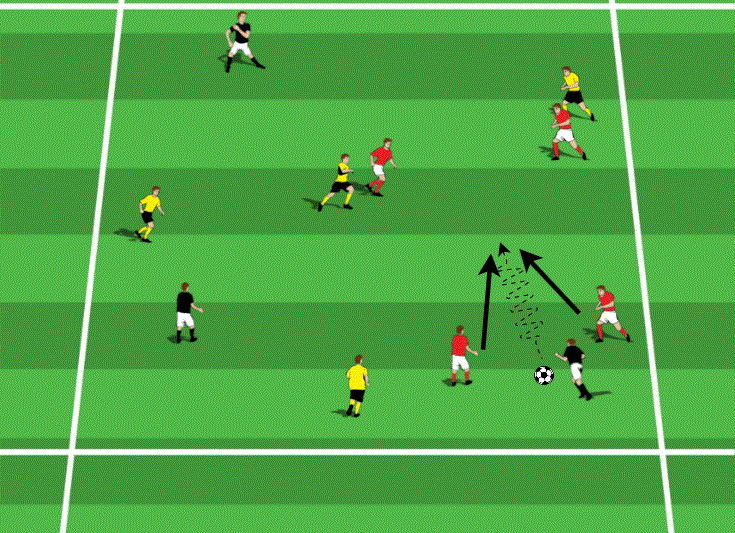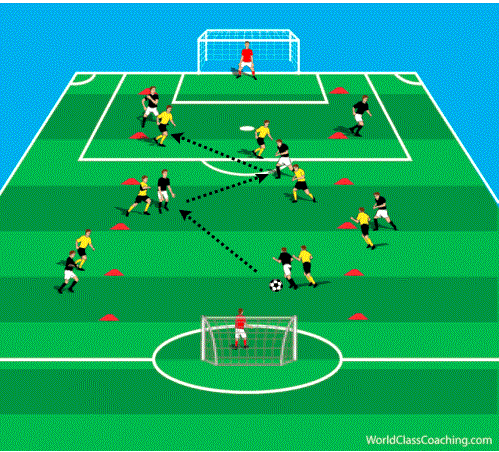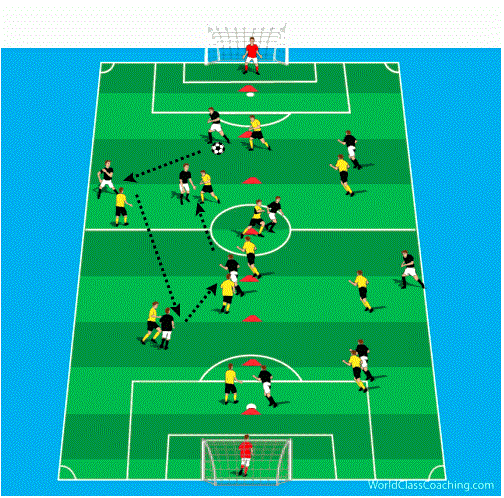By Chris Kouns
USSF A License (USSF Coaching Education Instructor) – NSCAA Premier Diploma (NSCAA Coaching Education Associate Staff Coach) – Head Women’s Soccer Coach – Georgia Gwinnett College
In these activities we are working on the player’s body positioning, movements and cues to better defend as a unit.
Exercise #1
In an area approximately 30 x 30 divide group into three teams. Two teams will try to maintain possession within the area while one team will attempt to work together to win the ball and maintain possession. When a team turn the ball over they will change places with the team who was defending.
PROGRESSIONS
- Begin with a turn over occurring when the defensive team touches the ball. This should prove successful for defending units if they are getting numbers around the ball.
- Advance to the turn over occurring when the defending team touches, knocks out of bounds or wins the ball.
- Advance to the turn over occurring only when the ball is won and possession is kept OR if the defending team forces the teams in possession to knock the ball out of bounds on their own due to pressure.
Coaching Points
- As a group identify where you want to try to win the ball and make sure that you have someone close enough to get “touch tight” in order to initiate the defensive pressure.
- When defending hunt in a pack so that you all go to an area, group of players or the ball at the same time. Coordinate your movement so that there will be very little time for the teams in possession to solve where they can get away.
- Players should work to identify quickly the possible “targets: the player with the ball has by looking at their body position. Chances are they will most likely play it to a player within the scope of their “hip bones”
- Communication is KEY! If someone is going to press but the pack cannot get there or keep up with them they must “call them off” and then redesign their attack when the pack can hunt together.
- Focus in picking the ball off or intercepting it as being more valuable than knocking it away because we will have possession and that is a very dangerous time for the other team (turnover)
Exercise #2
Utilizing half of a field and two full size goals divide the field into thirds vertically. When attacking the team with the ball must possess the ball at least three passes in a vertical channel before they are allowed to play into another channel. They are allowed to play vertically for their three passes and score goals as long as they do not change vertical lanes prior to three passes.
NOTE: These vertical channels and the number of designated passes allow the defending unit to more easily identify who the “likely” passing options will be. That will also allow them to compact the field defensively and find more success in winning the ball. On the opposite side when the ball is lost the transitioning team will now be able to reorganize themselves with defensive pressure before the ball escapes since it cannot leave the channel until the team winning the ball has completed three passes.
Coaching Points
- Players should focus on anticipating the direction of possession based on the body position of the player on the ball.
- The defending unit should look to take away vertical passes (both forward and backward) first as there is more space to defend and in a real game that is the direction of the goal.
- Make it a clear visual cue when a player receives the ball facing sideways in the channel, so they are looking out of bounds but still must complete more passes, that we must apply tremendous pressure so they cannot have time to solve the problem.
- The closest player to the ball must not let them turn so that all of the other members of the pack can pick off the likely targets for the next pass.
Exercise #3
Two teams are playing 11 v 11 on a full field which will be divided vertically into two sections. When attacking the team with the ball must possess the ball at least five passes in a vertical channel before they are allowed to play into another channel. They are allowed to play vertically for their five passes, and score goals, as long as they do not change vertical lanes prior to five passes.
Coaching Points
- With more ground to cover the defensive unit must compact the space to close the team in possession into just the one area and not allow them any easy escape routes to the other side.
- The farthest defending players must pay close attention to the body of the player on the ball. If they are about to be able to change vertical grids on their next path the defenders farthest from the ball must turn side on and be prepared to close as the ball travels to the next grid.
- When turning the ball over the transition defending team should send as many players as are near the ball to immediately try to win it back within the first five seconds. This is a mentality and may take someone with “Sharp” or “Demanding” communication to ensure players do not check out when the ball is lost
By Chris Kouns: USSF A License (USSF Coaching Education Instructor) – NSCAA Premier Diploma (NSCAA Coaching Education Associate Staff Coach) – Head Coach Georgia Gwinnet College Women’s Soccer (GA)





